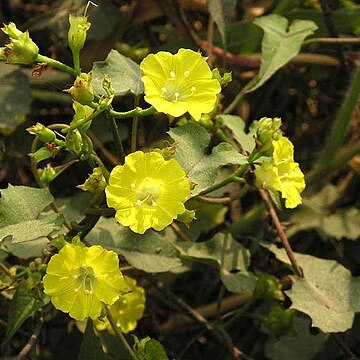Herbs, twining or prostrate; axial parts often minutely tuberculate. Stems glabrous or sparsely hirsute, rooting at nodes. Petiole 0.5-5 cm, glabrous or pubescent; leaf blade cordate-ovate, 1.5-7.5 X 1-5 cm, subglabrous to sparsely puberulent, base cordate or broadly cordate, margin entire, irregularly crenate, or 3-lobed. Inflorescences (1-) or few to many flowered, umbelliform, cymose in fruit; peduncle (0.3-)0.8-5 cm, thicker than petiole; bracts early deciduous, narrowly obovate. Pedicel 2-5 mm. Sepals broadly obovate to spatulate or oblong, reflexed in fruit, unequal; outer 2 sepals 3.5-4 mm; inner 3 ca. 5 mm, glabrous, apex emarginate and distinctly mucronate, mucro directed outward. Corolla yellow, campanulate, 6-10 mm, outside glabrous, inside villous basally. Stamens ca. as long as corolla; filaments sparsely villous basally. Ovary globose, glabrous; stigma globose. Capsule depressed globose or broadly conical, 5-6 mm, reticulate (but not coarsely) wrinkled. Seeds trigonous-globose, 2.5-3.5 mm, puberulent to glabrous or woolly along angles and at hilum. 2n = 30*.
A twining or prostrate herb; stems slender, glabrous or pubescent, often minutely tuberculate, sometimes rooting at the nodes.. Leaf-blade ovate in outline, 1.5–5 cm. long, 1.25–4 cm. wide, obtuse and mucronulate at the apex, cordate at the base, entire, crenate, or shallowly to deeply 3-lobed, glabrous or sparsely hairy; petiole 0.5–6 cm. long, sparsely tuberculate.. Flowers solitary or several in lax, branched inflorescences; peduncle 1–10 cm. long, usually glabrous or minutely tuberculate; pedicels 2–4 mm. long, similar.. Sepals obovate to spathulate, outer 3.5–4 mm. long, inner up to 5 mm. long, notched at the mucronulate apex, glabrous or sparsely pilose.. Corolla yellow or white, campanulate, 6–12 mm. long, glabrous outside, pilose inside at the base.. Capsule globose or conic, somewhat 4-angled, 5–6 mm. long; valves reticulately wrinkled.. Seeds pubescent or glabrous, 2.5 mm. long.
Flowers solitary or several in lax, branched inflorescences; peduncle 1–7 cm. long, thicker than the petioles, usually glabrous or minutely tuberculate; pedicels 1·2–8 mm., similar; bracts narrow-obovate, mucronulate, 3 mm. long, caducous.
A herb. It can be twining or lie along the ground. The stems form roots at the nodes. The leaves are heart shaped or oval and 2-8 cm long by 1-5 cm wide. They can have 3 lobes. The flowers can occur as few or many in a group.
Sepals obovate to spathulate, glabrous or occasionally slightly pilose on the reverse along the margins, concave, broadly notched at the apex, distinctly mucronulate, outer ones 3.5–4 mm. long, inner ones up to 5 mm. long.
Leaf lamina ovate, 1·5–5 × 1·2–3 cm., broadly crenate, or shallowly to deeply 3-lobed, glabrous or sparsely hairy; petiole 0·5–3 cm. long, slender, sparsely tuberculate, especially in the basal half.
Corolla yellow or white, campanulate, 5–12 mm. long, glabrous outside, pilose inside with long hairs near the hairy base of the filaments.
Stems slender, glabrous or pubescent, smooth or minutely tuberculate, sometimes rooting at the nodes.
Capsule globose or broadly conical, obscurely 4-angled; valves reticulately wrinkled.
A nearly glabrous twiner and climber, the stems often red-purple-tinged
Seeds more or less pubescent.
A twining or prostrate herb.
Rather small yellow flowers.

